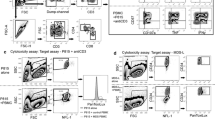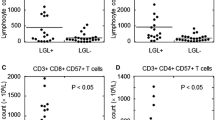Abstract
T-cell–targeting immunotherapy is now considered in acute myelogenous leukemia (AML). Immunotherapy seems most effective for patients with a low AML cell burden, and a possible strategy is therefore to administer immunotherapy early after intensive chemotherapy when patients have a low leukemia cell burden and severe treatment-induced cytopenia. To further investigate this possible therapeutic approach we used a whole blood assay to characterize the proliferative responsiveness (3H-thymidine incorporation) of circulating T cells from AML patients with severe treatment-induced leukopenia, i.e., peripheral blood leukocyte counts <0.5×109/l. This assay will reflect both quantitative and qualitative differences. Responses were compared for 17 AML patients, 6 patients with acute lymphoblastic leukemia (ALL), and a group of 21 healthy controls. Most circulating leukocytes in the AML patients were T lymphocytes, whereas B lymphocytes and monocytes usually constituted <10%. Anti-CD3-stimulated proliferation was significantly lower for AML patients compared with healthy controls. However, proliferation in response to anti-CD3 + anti-CD28 did not differ for AML patients and healthy controls, an observation suggesting that T cells from AML patients have an increased responsiveness in the presence of optimal costimulation that compensates for the quantitative T-cell defect. In contrast, the responses were significantly lower for ALL than for AML patients. We conclude that the remaining T-cell population in AML patients with severe chemotherapy-induced cytopenia show an increased proliferative responsiveness and may represent a therapeutic target when antileukemic immunotherapy is tried in combination with intensive chemotherapy.

Similar content being viewed by others
References
Anaissie E (1992) Opportunistic mycoses in the immunocompromised host: experience at a cancer center and review. Clin Infect Dis 14 [Suppl 1]:S43
Baird AM, Gerstein RM, Berg LJ (1999) The role of cytokine receptor signalling in lymphocyte development. Curr Opin Immunol 11:157
Bennett JM, Catovsky D, Daniel MT, Flandrin G, Galton DA, Gralnick HR, Sultan C (1976) Proposals for the classification of the acute leukaemias. Br J Haematol 33:451
Bishop JF, Matthews JP, Young GA, Szer J, Gillett A, Joshua D, Bradstock K, Enno A, Wolf MM, Fox R, Cobcroft R, Herrmann R, van der Weyden M, Lowenthal RM, Page F, Garson OM, Juneja (1990) A randomized study of high-dose cytarabine in induction in acute myeloid leukemia. Blood 87:1710
Bloemena E, Roos MT, van Heijst JL, Vossen JM, Schellekens PT (1989) Whole blood lymphocyte cultures. J Immunol Methods 122:161
Bruserud Ø (1998) Cellular immune responses in acute leukaemia patients with severe chemotherapy-induced leucopenia: characterization of the cytokine repertoire of clonogenic T cells. Cancer Immunol Immunother 46:221
Bruserud Ø (1998) IL-4, IL-10 and IL-13 in acute myelogenous leukemia. Cytokines Cell Mol Ther 4:187
Bruserud Ø, Ulvestad E (2000) Cytokine responsiveness of mitogen-activated T cells derived from acute leukemia patients with chemotherapy-induced leukopenia. J Interferon Cytokine Res 20:947
Bruserud Ø, Ulvestad E (2000) Acute myelogenous leukemia blasts as accessory cells during in vitro T lymphocyte activation. Cell Immunol 206:36
Bruserud Ø, Ulvestad E, Halstensen A, Berentsen S, Bergheim J, Nesthus I (1997) Interleukin 4 responses in acute leukaemia patients with severe chemotherapy-induced leucopenia. Eur J Haematol 59:269
Bruserud Ø, Ulvestad E, Berentsen S, Bergheim J, Nesthus I (1998) T lymphocyte functions in acute leukaemia patients with severe chemotherapy-induced cytopenia: characterization of clonogenic T cell proliferation. Scand J Immunol 47:54
Esber E, DiNicola W, Movassaghi N, Leikin S (1976) T and B lymphocytes in leukemia therapy. Am J Hematol 1:211
Fidel PL, Sobel JD (1994) The role of cell-mediated immunity in candidiasis. Trends Microbiol 2:202
Fonseca AM, Pereira CF, Porto G, Arosa FA (2003) Red blood cells promote survival and cell cycle progression of human peripheral blood T cells independently of CD58/LFA-3 and heme compounds. Cell Immunol 224:17
Hamilton G (2002) GM-CSF in inflammation and autoimmunity. Trends Immunol 23:403
Harris NL, Jaffe ES, Diebold J, Flandrin G, Muller-Hermelink HK, Vardiman J, Lister TA, Bloomfield CD (1999) World Health Organization classification of neoplastic diseases of the hematopoietic and lymphoid tissues: report of the Clinical Advisory Committee meeting, Airlie House, Virginia, November 1997. J Clin Oncol 17:3835
Koll BS, Brown AE (1993) The changing epidemiology of infections in cancer hospitals. Clin Infect Dis 17[Suppl 2]:S322
Kraut EH, Neff JC, Bouroncle BA, Gochnour D, Grever MR (1990) Immunosuppressive effects of pentostatin. J Clin Oncol 8:848
Larson RA, Dodge RK, Burns CP, Lee EJ, Stone RM, Schulman P, Duggan D, Davey FR, Sobol RE, Frankel SR, Hooberman AL, Westbrook CA, Arthur DC, George SL, Bloomfield CD, Schiffer CA. (1995) A five-drug remission induction regimen with intensive consolidation for adults with acute lymphoblastic leukemia: Cancer and Leukemia Group B study 8811. Blood 85:2025
Mackall CL (1999) T cell immunodeficiency following cytotoxic antineoplastic therapy: a review. Oncologist 4:370
Mackall CL, Fleischer TA, Brown MR, Magrath IT, Shad AT, Horowitz ME, Rubio M, Palau L, Vivas JR, del Potro E, Diaz-Mediavilla J, Alvarez A, Martinez R, Picazo JJ (1994) Lymphocyte depletion during treatment with intensive chemotherapy for cancer. Blood 84:2221
Mayer RJ, Davis RB, Schiffer CA, Berg DT, Powell BL, Schulman P, Omura GA, Moore JO, McIntyre OR, Frei E (1994) Intensive postremission chemotherapy in adults with acute myeloid leukemia. N Engl J Med 331:896
Rubio M, Palau L, Vivas JR, del Potro E, Diaz-Mediavilla J, Alvarez A, Martinez R, Picazo JJ (1994) Predominance of gram-positive microorganisms as a cause of septicemia in patients with hematological malignancies. Infect Control Hosp Epidemiol 15:101
Romani L, Howard DH (1995) Mechanisms of resistance to fungal infections. Curr Opin Immunol 7:517
Shurin MR, Esche C, Lotze MT (1998) FLT3: receptor and ligand. Cytokine Growth Factor Rev 9:37
Urba WJ, Baseler MW, Kopp WC, Steis RG, Clark JW, Smith JW, Coggin DL, Longo DL (1989) Deoxycoformycin-induced immunosuppression in patients with hairy cell leukemia. Blood 73:38.
Wendelbo Ø, Bruserud Ø (2003) Functional evaluation of proliferative T cell responses in patients with severe T lymphopenia: characterization of optimal culture conditions and standardized activation signals for a simple whole blood assay. J Hematother Stem Cell Res 12:525
Young LS (1994) Management of infections in leukemia and lymphoma. In: Rubin RH, Young LS (eds) Clinical approach to infection in the compromised host, 3rdedn. Plenum, New York, p 95
Acknowledgements
The work was supported by the Norwegian Cancer Society, the Rakel and Otto Christian Bruuns Foundation, and the Olaf Runshaugens Foundation.
Author information
Authors and Affiliations
Corresponding author
Rights and permissions
About this article
Cite this article
Wendelbo, Ø., Nesthus, I., Sjo, M. et al. Functional characterization of T lymphocytes derived from patients with acute myelogenous leukemia and chemotherapy-induced leukopenia. Cancer Immunol Immunother 53, 740–747 (2004). https://doi.org/10.1007/s00262-004-0505-0
Received:
Accepted:
Published:
Issue Date:
DOI: https://doi.org/10.1007/s00262-004-0505-0




